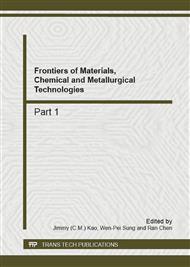[1]
J.R. Johnson, W.F. Bruce, and J.D. Dutcher, Gliotoxin, the antibiotic principle of Gliocladium fimbriatum. I. Production, physical and biological properties, J. Am. Chem. Soc. Vol. 65(1943), pp.2005-2009.
DOI: 10.1021/ja01250a051
Google Scholar
[2]
W.F. Bruce J.D. Dutcher J.R. Johnson,and L.L. Miller, Gliotoxin, the antibiotic principle of Gliocladium fimbriatum. II. General chemical behavior and crystalline derivatives, American Chemical Society, Vol. 66(1944), p.614–616.
DOI: 10.1021/ja01232a031
Google Scholar
[3]
J. Fridrichsons,and A.M. Mathieson, The crystal structure of gliotoxin, Acta Crystallogr., Vol. 23(1967), p.439–448.
DOI: 10.1107/s0365110x67002944
Google Scholar
[4]
R. Weindling, and O.H. Emerson, The isolation of a toxic substance from the culture filtrate of Trichoderma, Phytopath., Vol. 26(1936), pp.1068-1070.
Google Scholar
[5]
T.W. Jordan, and S.J. Cordiner, Fungal epipolythiodioxopiperazine toxins have therapeutic potential and roles in disease, Trends in Pharmacological Sciences, Vol. 8(1987),pp.144-149.
DOI: 10.1016/0165-6147(87)90184-2
Google Scholar
[6]
H.C. Ottenheijm, J.D. Herscheid, and M.W. Tijhuis,et al, Gliotoxin analogues as inhibitors of reverse transcriptase.1.Effect of lipophilicity, Journal of Medical Chemistry,Vol. 21(1978), pp.796-799.
DOI: 10.1021/jm00206a015
Google Scholar
[7]
P.L. Rodriguez, and L. Carrasco, Gliotoxin: inhibitor of poliovirus RNA synthesis that blocks the viral RNA polymerase 3Dpol, Journal of Virology, Vol. 66(1992), pp.1971-1977.
DOI: 10.1128/jvi.66.4.1971-1976.1992
Google Scholar
[8]
A. Mullbacher, P. Waring, and R.D. Eichner, Identification of an phagocytic and immunomodulating activityin vitro, Journal of General Microbiology, Vol. 131(1985) , pp.1251-1258.
DOI: 10.1099/00221287-131-5-1251
Google Scholar
[9]
R.D. Eichner, M. Salami, P.R. Wood, et al, The effect of gliotoxin upon macrophage function, International Immunopharmacology, Vol. 8(1986), pp.789-797.
DOI: 10.1016/0192-0561(86)90016-0
Google Scholar
[10]
P. Waring, R.D. Eichner, and A.Mullbacher, et a, Gliotoxin induces apoptosis in macrophages unrelated to its antiphagocytic properties, Journal of Biological Chemistry, Vol. 263(1988), pp.18493-18499.
DOI: 10.1016/s0021-9258(19)81385-6
Google Scholar
[11]
P. Waring, DNA fragmentation induced in macrophages by gliotoxin does not require protein synthesis and is preceded by raised inositol triphosphate levels, Journal of Biological Chemistry, Vol. 265(1990), pp.14476-14480.
DOI: 10.1016/s0021-9258(18)77327-4
Google Scholar
[12]
J.R. Lissing, B.E. Tuch, and M.G. Suranyi, The use of gliotoxin in human fetal pancreas transplantation, Transplantation Proceedings, Vol. 20(1988), pp.76-78.
Google Scholar
[13]
M. Kobayashi, A. Mullbacher, and P. Waring, et al, Gliotoxin treatment selectively spares M-CSF-plus IL-3-responsive multipotent haemopoietic progenitor cells in bone marrow, Eur. J. Haematol., Vol. 46(1991), pp.205-211.
DOI: 10.1111/j.1600-0609.1991.tb00542.x
Google Scholar
[14]
P.C. McMinn, G.M. Halliday, and H.K. Muller, Effects of gliotoxin on langerhans cell function: contact hypersensitivity responses and skin graft survival, Immunology, Vol. 71(1990), pp.46-51.
Google Scholar
[15]
P.C. McMinn, G.M. Holliday, and P. Waring, et a,l, Langerhans cell depletion in gliotoxin-treated murine epidermis, Pathology, Vol. 23(1991), pp.39-44.
DOI: 10.3109/00313029109061439
Google Scholar
[16]
J.E. Karp, and S. Broder, New directions in molecular medicine, Cancer Res., Vol. 54(1994), pp.653-665.
Google Scholar


